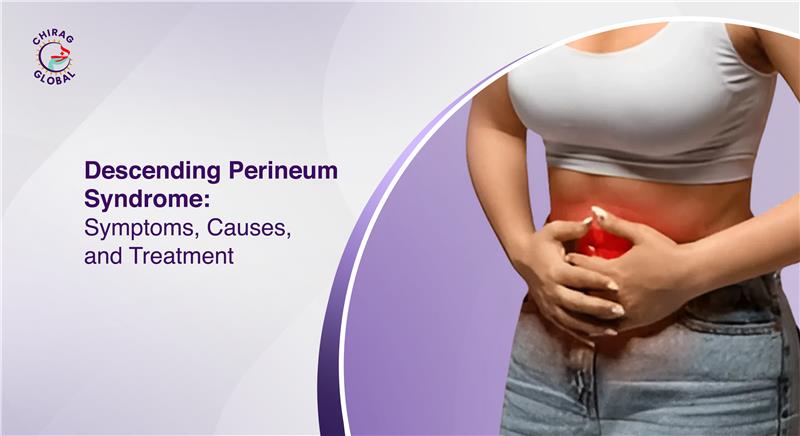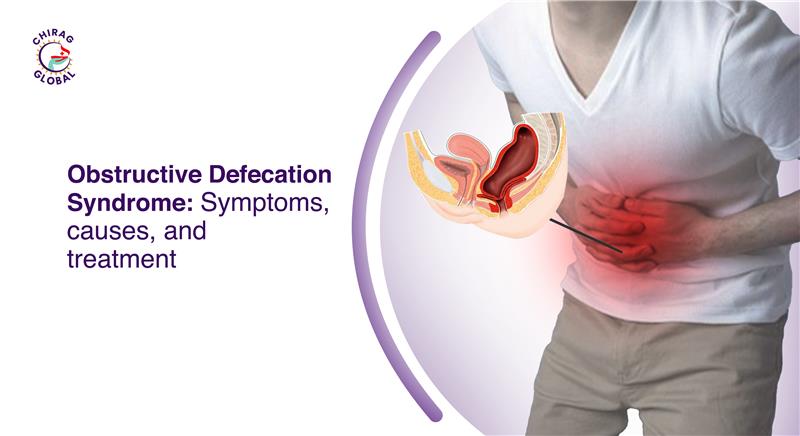By Chirag Global Hospitals

Bowel health is often taken for granted until problems begin to affect daily life. Chronic constipation, straining, or difficulty with bowel movements can sometimes indicate an underlying pelvic floor disorder. One such condition is Descending Perineum Syndrome (DPS).
Though not widely known among the public, DPS is an important cause of pelvic floor dysfunction. It can significantly reduce quality of life if left untreated, but with proper diagnosis and treatment, patients can find relief.
This article explains what DPS is, its symptoms, causes, diagnosis, and available treatments, in language designed for everyday readers while maintaining medical accuracy.
What is Descending Perineum Syndrome?
Descending Perineum Syndrome (DPS) is a condition where the perineum, the area between the anus and genitals, drops lower than normal during straining or bowel movements.
In a healthy pelvic floor, the perineum moves slightly downward when you pass stool, but in DPS, this downward movement becomes excessive. Over time, the tissues and muscles of the pelvic floor become stretched and weakened, leading to bowel and urinary dysfunction.
DPS is more common in middle-aged and older women, often related to childbirth trauma or chronic straining from constipation. However, men can also develop the condition.
Symptoms of Descending Perineum Syndrome
The symptoms of DPS may vary, but most patients experience difficulties related to bowel movements and pelvic support. Common signs include:
-
- Chronic constipation despite a high-fibre diet and hydration
-
- Straining excessively during bowel movements
-
- Sensation of incomplete evacuation
-
- Needing to use fingers (digital assistance) to empty the rectum
-
- Feeling of heaviness or bulging in the pelvic area
-
- Rectal prolapse (rectum protruding outside the anus in severe cases)
-
- Urinary incontinence (leakage of urine) or difficulty emptying the bladder
-
- Pelvic or lower back pain
Unlike occasional constipation, these symptoms are persistent and worsen over time, requiring medical attention.
What Are Its Causes and Risk Factors?
Descending Perineum Syndrome usually develops over time due to a combination of structural damage, muscle weakness, and lifestyle factors.
1. Structural Causes
-
- Childbirth trauma – Vaginal deliveries, especially multiple or difficult births, can stretch or injure pelvic muscles and nerves.
-
- Pelvic surgery – Hysterectomy or rectal surgery may weaken support structures.
-
- Chronic rectal prolapse – Long-term prolapse worsens perineal descent.
2. Functional Causes
-
- Chronic constipation – Regular straining puts pressure on the pelvic floor.
-
- Pelvic floor muscle weakness – Ageing or nerve dysfunction leads to reduced muscle control.
3. Risk Factors
-
- Female gender (especially after childbirth)
-
- Ageing (weaker muscles and tissues)
Obesity (extra pressure on the pelvic floor)
-
- Long-term laxative abuse
-
- Chronic respiratory conditions (coughing increases pelvic pressure)
How Does This Condition Affect the Body?
The pelvic floor is responsible for supporting the bladder, uterus (in women), and rectum. When it becomes overstretched, several complications can arise:
-
- Digestive issues: Long-term constipation, incomplete evacuation, rectal prolapse.
-
- Urinary problems: Incontinence or retention due to weak support.
-
- Sexual dysfunction: Pain or reduced sensation during intercourse.
-
- Quality of life impact: Embarrassment, social withdrawal, anxiety, and reduced physical activity.
Without treatment, DPS may progress, making daily life increasingly difficult.
Diagnosis: How It’s Identified
If you experience chronic constipation or pelvic floor symptoms, a doctor, usually a colorectal surgeon, gastroenterologist, or urogynecologist, may evaluate you for DPS.
Common diagnostic methods include:
-
- Physical examination: Checking perineal descent during straining.
-
- Defecography (X-ray or MRI): Imaging performed while passing stool to observe pelvic movement.
-
- Anorectal manometry: Measures muscle function and coordination.
-
- Endoanal ultrasound: Assesses pelvic muscle structure.

Defecography
Defecography is a specialised imaging test that records real-time video X-rays of the rectum and anal canal while a patient mimics a bowel movement, often by evacuating a contrast paste or gel introduced into the rectum. This allows clinicians to assess the mechanics and coordination of pelvic floor muscles and determine causes of chronic constipation, fecal incontinence, or obstructed defecation, visualising issues such as rectal prolapse, rectocele, or pelvic floor dysfunction.
Anorectal Manometry
Anorectal manometry is a diagnostic procedure that measures pressures within the rectum and anal canal using a thin tube equipped with pressure sensors. Evaluating muscle strength, coordination, and nerve reflexes helps identify functional disorders such as chronic constipation, fecal incontinence, or Hirschsprung’s disease, and assesses overall rectal and anal sphincter performance.
Endoanal Ultrasound
Endoanal ultrasound involves insertion of a small probe into the anal canal to generate real-time, detailed images of the internal and external anal sphincter muscles. This test is primarily used to detect structural abnormalities, including sphincter injuries or defects, commonly resulting from childbirth, surgery, or trauma, thus guiding treatment for patients with fecal incontinence.
Treatment Options Available
Treatment for DPS depends on severity and underlying causes. Doctors usually begin with conservative approaches before considering surgery.
1. Lifestyle & Conservative Management
-
- Dietary changes: High-fibre foods, proper hydration.
-
- Avoiding straining: Using a footstool (squat position) during bowel movements.
-
- Pelvic floor physiotherapy: Exercises to strengthen and retrain pelvic muscles.
How it will Help: Dietary changes such as eating high-fibre foods and maintaining proper hydration help keep stools soft and regular, reducing strain during bowel movements. Using a footstool to mimic a squat position can straighten the recto-anal angle, making defecation easier and less stressful for the pelvic floor. Pelvic floor physiotherapy involves exercises that strengthen and retrain pelvic muscles to enhance control, support, and coordination, helping relieve symptoms such as incontinence and obstructed defecation.
2. Biofeedback Therapy
This non-invasive treatment helps patients learn how to coordinate pelvic floor muscles properly. It is effective for mild to moderate cases.
How it will Help: Biofeedback therapy is a non-invasive technique that teaches patients to properly coordinate their pelvic floor muscles with visual or sensory feedback. This method helps correct abnormal muscle patterns (dyssynergia) and improve muscle relaxation during bowel movements, significantly improving chronic constipation, incomplete evacuation, and fecal incontinence in mild to moderate cases. Evidence suggests biofeedback is more effective than laxatives or dietary modifications for dyssynergic defecation.
3. Medications
-
- Stool softeners or osmotic laxatives (prescribed under medical guidance).
-
- Avoid self-medication with stimulant laxatives, which can worsen symptoms.
How it will Help: Stool softeners and osmotic laxatives (prescribed by doctors) help keep stools soft and easier to pass without excessive straining, minimising pressure on the pelvic floor muscles. Avoiding self-medication with stimulant laxatives is recommended, as overuse can lead to dependence or worsen dysfunction over time.
4. Surgical Options
Surgery may be necessary for severe DPS, particularly when associated with rectal prolapse. Options include:
-
- Rectopexy: Securing the rectum in place.
-
- Perineal repair: Strengthening perineal tissues.
-
- Combined surgeries: Correcting rectocele or prolapse if present.
How it will Help: Surgery may be necessary in severe DPS, especially when structural damage like rectal prolapse is present. Rectopexy secures the rectum to correct prolapse and prevent further descent. Perineal repair strengthens the tissues around the anal and perineal region to support pelvic floor integrity. Combined surgeries may address multiple defects (such as rectocele or concurrent prolapse), aiming for comprehensive restoration of proper bowel mechanics and continence.
Surgery is recommended only after thorough evaluation and when conservative measures fail.
 When to Seek Immediate Medical Attention
When to Seek Immediate Medical Attention
While Descending Perineum Syndrome often develops gradually, certain symptoms require prompt medical evaluation:
-
- Severe rectal bleeding that does not stop
-
- A prolapsed rectum that remains outside the body and cannot be pushed back in
-
- Severe abdominal pain or bloating with inability to pass stool or gas
-
- Unexplained weight loss with chronic constipation
-
- Sudden worsening of urinary incontinence or inability to urinate
If you experience any of these warning signs, seek immediate medical care. They may indicate complications or another serious underlying condition.
What is Pelvic Floor Disease?
Pelvic floor disease refers to a group of conditions that affect the muscles, ligaments, and connective tissues supporting the pelvic organs (bladder, uterus, vagina, rectum, and anus).
When the pelvic floor is weakened, injured, or does not coordinate properly, it can lead to:
-
- Urinary problems (incontinence, difficulty starting or stopping urination)
-
- Bowel issues (constipation, obstructive defecation syndrome, fecal incontinence)
-
- Pelvic organs prolapse (descent of the bladder, rectum, or uterus into the vaginal canal)
-
- Sexual dysfunction (pain or discomfort during intercourse)
Pelvic floor disease is especially common in women after childbirth, menopause, or pelvic surgery, but it can also affect men. Treatments may include pelvic floor physiotherapy, medications, biofeedback, or surgery, depending on severity.
What Is the Outlook for People with This Condition?
The outlook for DPS depends on early detection, patient compliance with therapy, and severity at diagnosis.
-
- Mild cases: Often managed successfully with physiotherapy and lifestyle adjustments.
-
- Moderate to severe cases: May require surgery, but outcomes are generally favourable with improved bowel function and reduced symptoms.
-
- Long-term management: Regular follow-ups, pelvic floor care, and healthy bowel habits are essential to prevent recurrence.
FAQs About Descending Perineum Syndrome
1. Is descending perineum syndrome the same as rectal prolapse?
Not exactly. While both involve pelvic floor dysfunction, DPS refers to excessive perineal descent, whereas rectal prolapse is the physical protrusion of the rectum. However, both conditions may occur together.
2. Can pelvic floor exercises help in descending perineum syndrome?
Yes. Pelvic floor physiotherapy and biofeedback can help strengthen weak muscles and improve bowel control in mild to moderate cases.
3. Who is most at risk of developing descending perineum syndrome?
Women who have had multiple vaginal deliveries, older adults, people with chronic constipation, and those with pelvic surgeries are at higher risk.
4. Can DPS go away on its own?
No. DPS usually worsens over time if left untreated. Early medical evaluation is recommended to prevent complications.
Integrative Care: The Role of Ayurveda in Pelvic Floor Health
Integrative care approaches recognise the potential role of Ayurveda as a supportive therapy for pelvic floor health, particularly alongside conventional management for Descending Perineum Syndrome (DPS). Scientifically neutral language, such as “Some clinical studies suggest Ayurveda may support bowel health, though more research is needed,” helps ensure balanced credibility.
1. Basti Therapy (Medicated Enema)
-
- In Ayurveda, Basti is considered one of the most effective treatments for conditions related to the colon and pelvic floor.
-
- Medicated oils or herbal decoctions are administered rectally to nourish pelvic tissues, improve bowel movement, and strengthen muscles.
-
- It is especially recommended for chronic constipation and pelvic floor weakness.
2. Dietary Regulation
-
- Ayurveda emphasises a fibre-rich, easily digestible diet to maintain healthy bowel habits.
-
- Warm, cooked foods with adequate hydration are encouraged to reduce strain.
-
- Herbs like Triphala (a natural colon cleanser) may be prescribed by Ayurvedic physicians to support smooth evacuation.
3. Strengthening and Rejuvenation Approaches
-
- Yoga postures such as Malasana (squat pose), Ashwini Mudra (anal contraction exercise), and Moola Bandha (root lock) help tone pelvic floor muscles.
-
- Herbal formulations (like Ashwagandha and Shatavari) may be used to rejuvenate tissues and improve muscular resilience.
-
- Stress management through Ayurvedic massage, meditation, and lifestyle balancing further supports recovery.
Ayurvedic therapies can improve bowel function, reduce dependency on laxatives and enhance overall quality of life.
Conclusion
Descending Perineum Syndrome is a lesser-known but significant, bowel difficulties and reduced quality of life. It develops due to muscle weakness, structural damage, and long-term straining, particularly in women after childbirth.
The condition is treatable with lifestyle changes, physiotherapy, biofeedback, medications, and, in severe cases, surgery. At the same time, holistic support through Ayurvedic therapies such as Basti, dietary regulation, and pelvic floor strengthening practices can further enhance bowel health and improve outcomes.
Chiraayu, the Ayurvedic wing of Chirag Global Hospitals, offers an integrative approach to managing Descending Perineum Syndrome, blending modern medical expertise with traditional Ayurvedic therapies to help patients regain comfort, balance, and quality of life.
If you or a loved one struggles with chronic constipation or pelvic floor symptoms, do not ignore them; consult a specialist promptly.
Medical Disclaimer: This article is for educational purposes only and does not replace professional medical consultation. Always consult a qualified healthcare provider for diagnosis and treatment.





